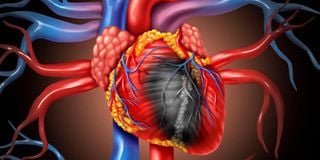WHO study: Half of people with hypertension unaware

The cardiovascular system supplies blood throughout the body and is made up of the heart, arteries, veins and capillaries.
What you need to know:
- Countries urged to make hypertension treatment part of primary care.
- World health agency says about one in three people in the world have hypertension.
About half of the world’s population living with high blood pressure are unaware of their condition while four out of five people with the condition are under-treated, a new report shows.
The report released by the World Health Organization (WHO) yesterday on the sidelines of the 78th session of the United Nations General Assembly (UNGA), details the devastating impact of the disease and suggests ways to step up prevention.
While noting that hypertension affects one in three people worldwide, WHO indicated that if countries scale up coverage, 76 million deaths could be prevented between now and 2050.
Hypertension occurs when the pressure in the blood vessels is higher than normal, with a reading of 140/90 mmHg or higher.
The report shows that between 1990 and 2019, the number of people living with hypertension worldwide doubled from just over half a million to around 1.3 billion.
It explains that older people and those with a family history of the condition are more likely to be diagnosed with it.
“Modifiable risk factors such as a high-salt diet, lack of physical activity and excessive alcohol consumption can also increase the risk of hypertension,” the report says. It recommends being physically active, eating a healthier diet and quitting tobacco to reduce the risk of being diagnosed with the disease.
According to the WHO, countries with good hypertension treatment programmes have better economic outcomes.
“Prevention, early detection and effective treatment of hypertension are among the most cost-effective interventions in health care and should be prioritised by countries as part of their national health care package at primary care level,” the report recommends.
WHO Director-General Tedros Adhanom Ghebreyesus said that although the condition is manageable, only one in five people are able to control it.
“Hypertension control programmes remain neglected, under-prioritised and severely underfunded. Strengthening hypertension control must be part of every country’s journey towards universal health coverage, based on well-functioning, equitable and resilient health systems built on a foundation of primary health care,” he said.
CEO and President of Resolve to Save Lives Tom Frieden said at the launch of the report that more than 1,000 people die every hour from strokes and heart attacks.
“Most of these deaths are caused by high blood pressure, and most of them could have been prevented. Good hypertension care is affordable, within reach and strengthens primary health care. The challenge now is to move from ‘within reach’ to ‘reached’. This will require the commitment of governments around the world,” he said.
The report shows that more than three-quarters of adults living with the disease are from low- and middle-income countries such as Kenya.
The latest Kenya Demographic Health Survey shows that the prevalence of the disease increases as people get older and more women than men have it. The data shows that only about 2 per cent of women aged 15-49 in Kenya have high blood pressure, but this figure rises tenfold for women aged 45-49.
Kirinyaga, Taita Taveta and Laikipia counties, in that order, have the highest number of women with high blood pressure. On the other hand, Homa Bay and Embu counties had the highest percentage of men living with it.
The report states that if countries increased their treatment levels to those of high-performing countries, about 76 million deaths, 120 million strokes, 79 million heart attacks and 17 million cases of heart failure could be prevented by 2050.





